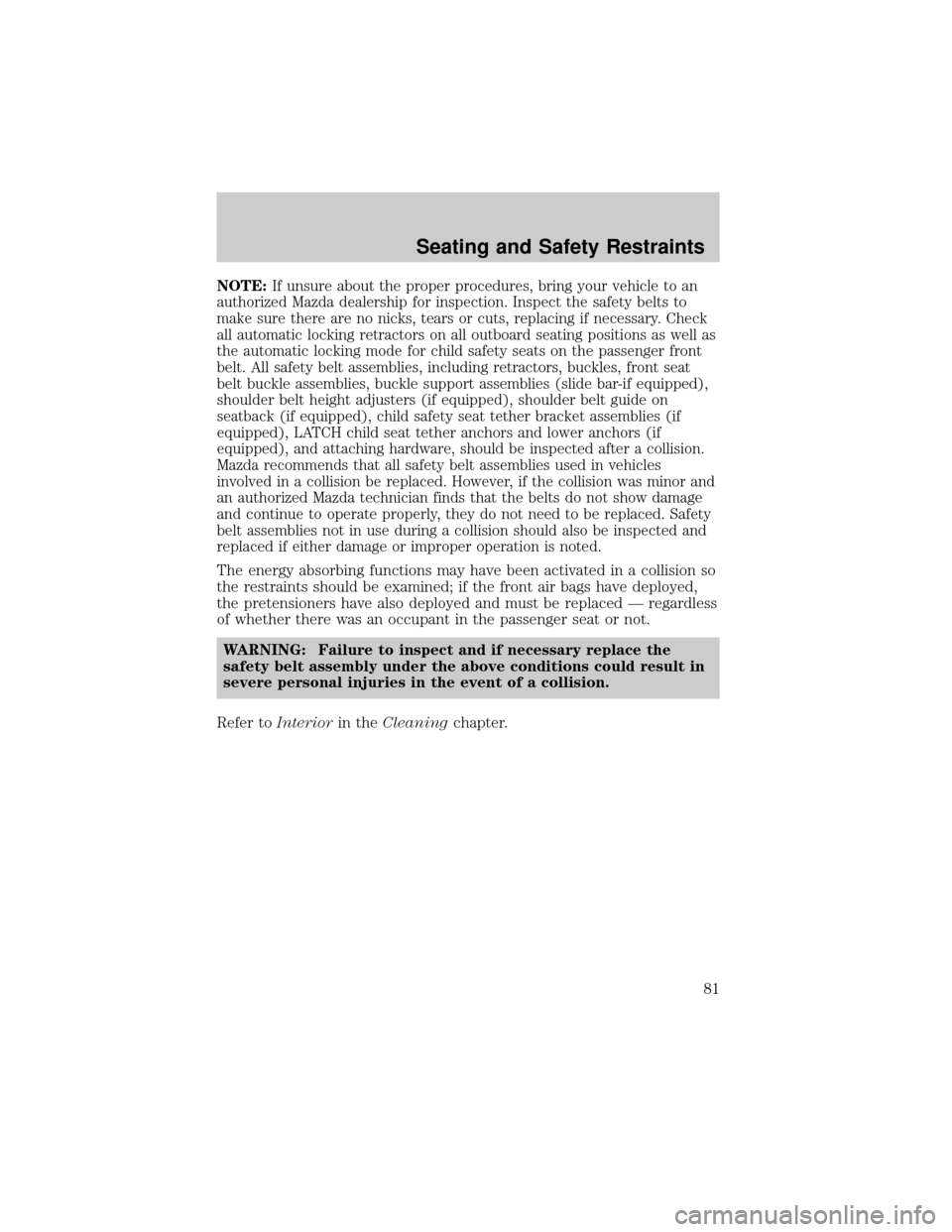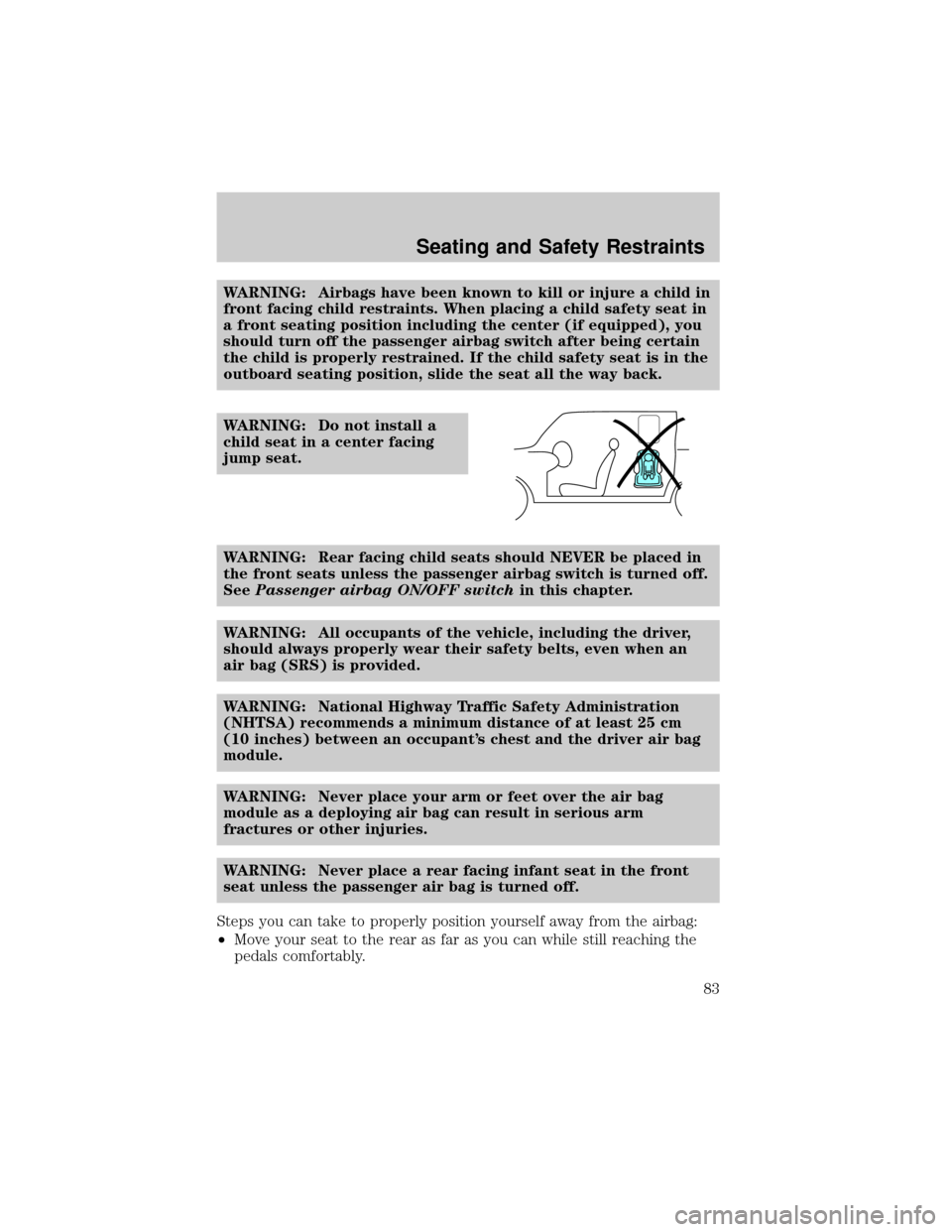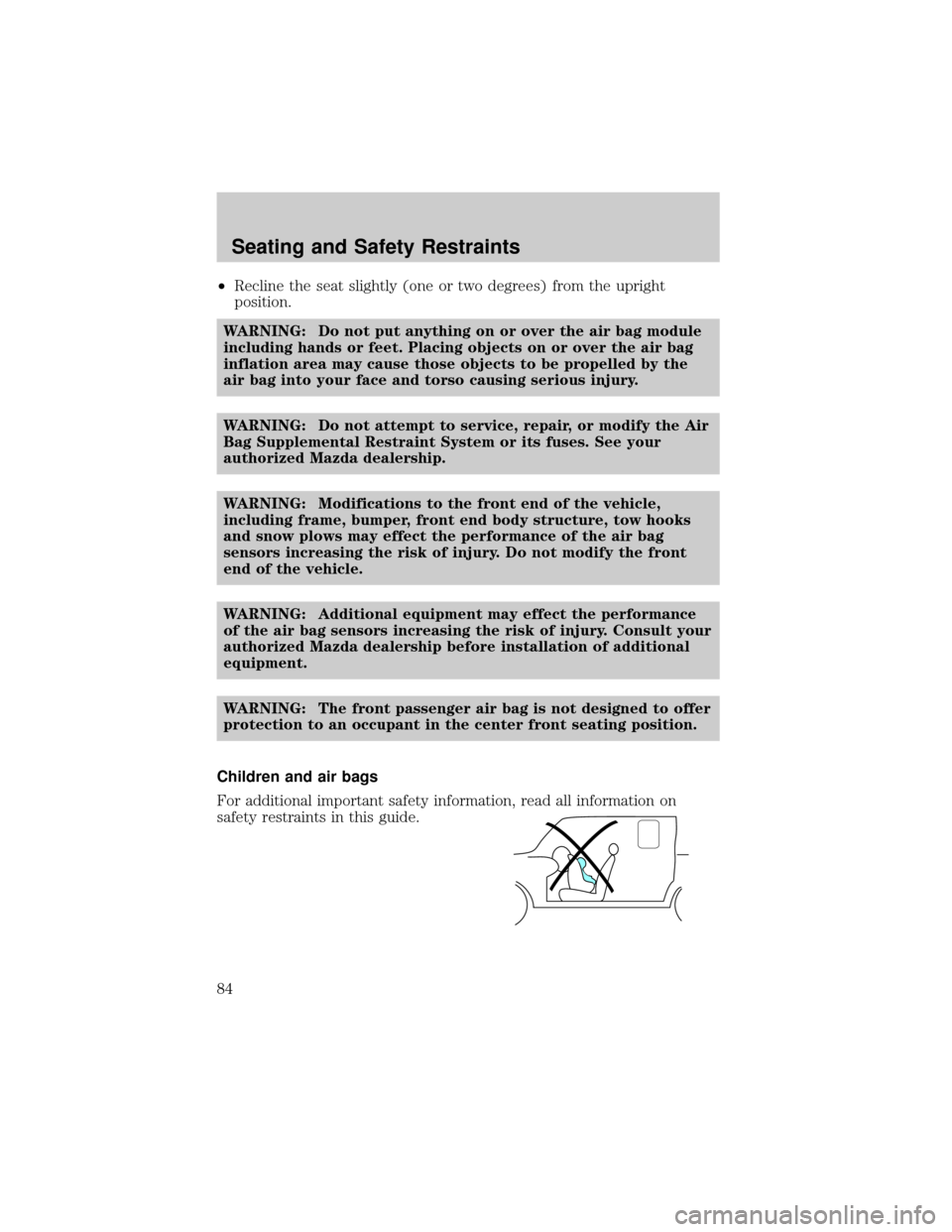MAZDA MODEL B-SERIES 2003 (in English) Manual Online
Manufacturer: MAZDA, Model Year: 2003, Model line: MODEL B-SERIES, Model: MAZDA MODEL B-SERIES 2003Pages: 245, PDF Size: 2.33 MB
Page 81 of 245

NOTE:If unsure about the proper procedures, bring your vehicle to an
authorized Mazda dealership for inspection. Inspect the safety belts to
make sure there are no nicks, tears or cuts, replacing if necessary. Check
all automatic locking retractors on all outboard seating positions as well as
the automatic locking mode for child safety seats on the passenger front
belt. All safety belt assemblies, including retractors, buckles, front seat
belt buckle assemblies, buckle support assemblies (slide bar-if equipped),
shoulder belt height adjusters (if equipped), shoulder belt guide on
seatback (if equipped), child safety seat tether bracket assemblies (if
equipped), LATCH child seat tether anchors and lower anchors (if
equipped), and attaching hardware, should be inspected after a collision.
Mazda recommends that all safety belt assemblies used in vehicles
involved in a collision be replaced. However, if the collision was minor and
an authorized Mazda technician finds that the belts do not show damage
and continue to operate properly, they do not need to be replaced. Safety
belt assemblies not in use during a collision should also be inspected and
replaced if either damage or improper operation is noted.
The energy absorbing functions may have been activated in a collision so
the restraints should be examined; if the front air bags have deployed,
the pretensioners have also deployed and must be replaced Ð regardless
of whether there was an occupant in the passenger seat or not.
WARNING: Failure to inspect and if necessary replace the
safety belt assembly under the above conditions could result in
severe personal injuries in the event of a collision.
Refer toInteriorin theCleaningchapter.
Seating and Safety Restraints
81
Page 82 of 245

AIR BAG SUPPLEMENTAL RESTRAINT SYSTEM (SRS)
Important supplemental restraint system (SRS) precautions
The supplemental restraint system is designed to work with the safety
belt to help protect the driver and right front passenger from certain
upper body injuries.
WARNING: Air bags DO NOT
inflate slowly or gently and the
risk of injury from a deploying
air bag is greatest close to the
trim covering the air bag
module. Always wear your
safety belt.
Seating and Safety Restraints
82
Page 83 of 245

WARNING: Airbags have been known to kill or injure a child in
front facing child restraints. When placing a child safety seat in
a front seating position including the center (if equipped), you
should turn off the passenger airbag switch after being certain
the child is properly restrained. If the child safety seat is in the
outboard seating position, slide the seat all the way back.
WARNING: Do not install a
child seat in a center facing
jump seat.
WARNING: Rear facing child seats should NEVER be placed in
the front seats unless the passenger airbag switch is turned off.
SeePassenger airbag ON/OFF switchin this chapter.
WARNING: All occupants of the vehicle, including the driver,
should always properly wear their safety belts, even when an
air bag (SRS) is provided.
WARNING: National Highway Traffic Safety Administration
(NHTSA) recommends a minimum distance of at least 25 cm
(10 inches) between an occupant's chest and the driver air bag
module.
WARNING: Never place your arm or feet over the air bag
module as a deploying air bag can result in serious arm
fractures or other injuries.
WARNING: Never place a rear facing infant seat in the front
seat unless the passenger air bag is turned off.
Steps you can take to properly position yourself away from the airbag:
²Move your seat to the rear as far as you can while still reaching the
pedals comfortably.
Seating and Safety Restraints
83
Page 84 of 245

²Recline the seat slightly (one or two degrees) from the upright
position.
WARNING: Do not put anything on or over the air bag module
including hands or feet. Placing objects on or over the air bag
inflation area may cause those objects to be propelled by the
air bag into your face and torso causing serious injury.
WARNING: Do not attempt to service, repair, or modify the Air
Bag Supplemental Restraint System or its fuses. See your
authorized Mazda dealership.
WARNING: Modifications to the front end of the vehicle,
including frame, bumper, front end body structure, tow hooks
and snow plows may effect the performance of the air bag
sensors increasing the risk of injury. Do not modify the front
end of the vehicle.
WARNING: Additional equipment may effect the performance
of the air bag sensors increasing the risk of injury. Consult your
authorized Mazda dealership before installation of additional
equipment.
WARNING: The front passenger air bag is not designed to offer
protection to an occupant in the center front seating position.
Children and air bags
For additional important safety information, read all information on
safety restraints in this guide.
Seating and Safety Restraints
84
Page 85 of 245

WARNING: Never place a rearward facing child safety restraint
in front of an airbag. Airbags have been known to kill or injure
children in front facing child safety restraints. Whenever
placing a child safety seat in a front seating position (including
center if equipped), turn off the passenger side air bag switch
after being certain the child is properly restrained. If using a
forward facing child safety restraint in the front outboard seat,
slide the seat all the way back, and turn off the passenger air
bag. If using a rear facing child safety seat in the front
outboard seating position, make sure the passenger airbag is
turned off and slide the passenger seat all the way forward
until the safety seat rests on the dashboard. SeePassenger air
bag on/off switchin this chapter.
WARNING: Do not install a
child seat in a center facing
jump seat.
WARNING: An air bag can kill
or injure a child in a child
seat. Child seats should never
be placed in the front seats,
unless passenger air bag
switch is turned off. See
Passenger air bag on/off
switchin this chapter.
WARNING: Rear facing child seats should NEVER be placed in
the front seats unless the passenger airbag switch is turned off.
WARNING: Booster seats must be installed only in seating
positions equipped with a combination lap/shoulder belt.
WARNING: To reduce the risk of injury, make sure children sit
where they can be properly restrained.
Seating and Safety Restraints
85
Page 86 of 245

How does the air bag supplemental restraint system work?
The air bag SRS is designed to
activate when the vehicle sustains
sufficient longitudinal deceleration.
The fact that the air bags did not
inflate in a collision does not mean
that something is wrong with the
system. Rather, it means the forces
were not of the type sufficient to
cause activation. Air bags are
designed to inflate in frontal and
near-frontal collisions, not rollover,
side-impact, or rear-impacts.
The air bags inflate and deflate
rapidly upon activation. After air bag
deployment, it is normal to notice a
smoke-like, powdery residue or
smell the burnt propellant. This may
consist of cornstarch, talcum
powder (to lubricate the bag) or
sodium compounds (e.g., baking
soda) that result from the
combustion process that inflates the
air bag. Small amounts of sodium
hydroxide may be present which
may irritate the skin and eyes, but
none of the residue is toxic.
While the system is designed to help
reduce serious injuries, it may also
cause minor abrasions, swelling or temporary hearing loss. Because air
bags must inflate rapidly and with considerable force, there is the risk of
death or serious injuries such as fractures, facial and eye injuries or
internal injuries, particularly to occupants who are not properly
restrained or are otherwise out of position at the time of air bag
deployment. Thus, it is extremely important that occupants be properly
restrained as far away from the air bag module as possible while
maintaining vehicle control.
Seating and Safety Restraints
86
Page 87 of 245

WARNING: Several air bag system components get hot after
inflation. Do not touch them after inflation or you may be
burned.
WARNING: If the air bag has deployed, the air bag will not
function again and must be replaced immediately. If the air bag
is not replaced, the unrepaired area will increase the risk of
injury in a collision.
The SRS consists of:
²driver and passenger air bag modules (which include the inflators and
air bags),
²passenger air bag deactivation switch and restraint control module
(RCM)
²a readiness light and tone,
²and the electrical wiring which connects the components.
The RCM (restraints control module) monitors its own internal circuits
and the supplemental air bag electrical system warning (including the
passenger air bag deactivation switch, the system wiring, the air bag
system readiness light, the air bag back up power and the air bag
ignitors).
Determining if the system is operational
The SRS uses readiness lights in the instrument cluster and the
passenger air bag deactivate switch or a tone to indicate the condition of
the system. Refer to theAir bag readinesssection in the
Instrumentationchapter orPassenger air bag deactivate switch
section in this chapter. Routine maintenance of the air bag is not
required.
A difficulty with the system is indicated by one or more of the following:
²The readiness lights will either
flash or stay lit.
²The readiness lights will not
illuminate immediately after
ignition is turned on.
²A series of five beeps will be heard. The tone pattern will repeat
periodically until the problem and/or light are repaired.
Seating and Safety Restraints
87
Page 88 of 245

If any of these things happen, even intermittently, have the SRS serviced
at your authorized Mazda dealership immediately.
WARNING: Unless serviced, the system may not function
properly in the event of a collision.
Disposal of air bags and air bag equipped vehicles
(including safety belt pretensioners)
For disposal of safety belt pretensioners, air bags, or air bag equipped
vehicles, see your authorized Mazda dealership or qualified technician.
Air bags MUST BE disposed of by qualified personnel.
Passenger air bag ON/OFF switch
WARNING: An air bag
ON/OFF switch has been
installed in this vehicle. Before
driving,alwayslook at the
face of the switch to be sure
the switch is in the proper
position in accordance with
these instructions and
warnings. Failure to put the
switch in a proper position can
increase the risk of serious
injury or death in a collision.
Turning the passenger air bag off
1. Ignition OFF.
2. Insert the ignition key, turn the
switch to OFF position and hold
in OFF position while removing
the key.
3. When the ignition switch is
turned to the ON position the
OFF light illuminates briefly,
momentarily shuts off and then
turns back on. This indicates that the passenger air bag is
deactivated.
ON
OFF
OFF
PASSENGER AIRBAG
ON
OFF
OFF
PASSENGER AIRBAG
Seating and Safety Restraints
88
Page 89 of 245

WARNING: If the OFF light fails to illuminate when the
passenger air bag switch is in the OFF position and the ignition
switch is in ON, have the passenger air bag switch serviced at
you authorized Mazda dealership.
WARNING: In order to avoid inadvertent activation of the
switch, always remove the ignition key from the passenger air
bag ON/OFF switch.
Turning the passenger air bag back on
The passenger air bag remains OFF until you turn it back ON.
1. Insert the ignition key and turn
the switch to ON.
2. The OFF light will briefly
illuminate when the ignition is
turned to ON. This indicates
that the passenger air bag is
operational.
WARNING: If the light is illuminated when the passenger air
bag ON/OFF switch is in the ON position and the ignition switch
is ON, have the passenger air bag ON/OFF switch serviced at
your authorized Mazda dealership immediately.
The passenger side air bag should always be ON (the air bag OFF light
shouldnotbe illuminated) unless the passenger is a person who meets
the requirements stated either in Category 1, 2 or 3 of the
NHTSA/Transport Canada deactivation criteria which follows.
ON
OFF
OFF
PASSENGER AIRBAG
Seating and Safety Restraints
89
Page 90 of 245

WARNING: The safety belts for the driver and right front
passenger seating positions have been specifically designed to
function together with the air bags in certain types of crashes.
When you turn OFF your air bag, you not only lose the
protection of the air bag, you also may reduce the effectiveness
of your safety belt system, which was designed to work with the
air bag. If you are not a person who meets the requirements
stated in the NHTSA/Transport Canada deactivation criteria
turning OFF the air bag can increase the risk of serious injury
or death in a collision.
WARNING: Always use safety belts and child restraints
properly. If a child in a rear facing infant seat must be
transported in front, the passenger air bagmustbe turned OFF.
This is because the back of the infant seat is too close to the
inflating air bag and the risk of a fatal injury to the infant when
the air bag inflates is substantial.
The vast majority of drivers and passengers are much safer with an air
bag than without. To do their job and reduce the risk of life threatening
injuries, air bags must open with great force, and this force can pose a
potentially deadly risk in some situations, particularly when a front seat
occupant is not properly buckled up. The most effective way to reduce
the risk of unnecessary air bag injuries without reducing the overall
safety of the vehicle is to make sure all occupants are properly
restrained in the vehicle, especially in the front seat. This provides the
protection of safety belts and permits the air bags to provide the
additional protection they were designed to provide. If you choose to
deactivate your air bag, you are losing the very significant risk reducing
benefits of the air bag and you are also reducing the effectiveness of the
safety belts, because safety belts in modern vehicles are designed to
work as a safety system with the air bags.
Read all air bag Warning labels in the vehicle as well as the other
important air bag instructions and Warnings in this Owner's Guide.
NHTSA deactivation criteria (excluding Canada)
1.Infant.An infant (less than 1 year old) must ride in the front seat
because:
²the vehicle has no rear seat;
²the vehicle has a rear seat too small to accommodate a rear-facing
infant seat; or
Seating and Safety Restraints
90